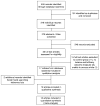The effect of interventions on balance self-efficacy in the stroke population: a systematic review and meta-analysis
- PMID: 25681409
- PMCID: PMC4596690
- DOI: 10.1177/0269215515570380
The effect of interventions on balance self-efficacy in the stroke population: a systematic review and meta-analysis
Abstract
Objective: To conduct a systematic review of clinical trials that examined the effectiveness of interventions on balance self-efficacy among individuals with stroke.
Design: Systematic review.
Summary of review: Searches of the following databases were completed in December 2014: MEDLINE (1948-present), CINAHL (1982-present), EMBASE (1980-present) and PsycINFO (1987-present) for controlled clinical trials that measured balance self-efficacy in adults with stroke. Reference lists of selected articles were hand-searched to identify further relevant studies.
Review methods: Two independent reviewers performed data extraction and assessed the methodological quality of the studies using the Physical Therapy Evidence Database Scale. Standardized mean differences (SMD) were calculated.
Results: A total of 19 trials involving 729 participants used balance self-efficacy as a secondary outcome. Study quality ranged from poor (n = 3) to good (n = 8). In the meta-analysis of 15 trials that used intensive physical activity interventions, a moderate beneficial effect on balance self-efficacy was observed immediately following the programs (SMD 0.44, 95% CI 0.11-0.77, P = 0.009). In the studies that included follow-up assessments, there was no difference between groups across retention periods (eight studies, SMD 0.32, 95% CI -0.17-0.80, P = 0.20). In the four studies that used motor imagery interventions, there was no between-group difference in change in balance self-efficacy (fixed effects SMD 0.68, 95% CI -0.33-1.69, P = 0.18).
Conclusions: Physical activity interventions appear to be effective in improving balance self-efficacy after stroke.
Keywords: Stroke; balance; meta-analysis; self-efficacy; systematic review.
© The Author(s) 2015.
Conflict of interest statement
The authors declare no conflicts of interest
Figures



Similar articles
-
Yoga for stroke rehabilitation.Cochrane Database Syst Rev. 2017 Dec 8;12(12):CD011483. doi: 10.1002/14651858.CD011483.pub2. Cochrane Database Syst Rev. 2017. PMID: 29220541 Free PMC article.
-
Selective serotonin reuptake inhibitors (SSRIs) for stroke recovery.Cochrane Database Syst Rev. 2012 Nov 14;11(11):CD009286. doi: 10.1002/14651858.CD009286.pub2. Cochrane Database Syst Rev. 2012. Update in: Cochrane Database Syst Rev. 2019 Nov 26;2019(11). doi: 10.1002/14651858.CD009286.pub3. PMID: 23152272 Free PMC article. Updated.
-
Mind and body therapy for fibromyalgia.Cochrane Database Syst Rev. 2015 Apr 9;2015(4):CD001980. doi: 10.1002/14651858.CD001980.pub3. Cochrane Database Syst Rev. 2015. PMID: 25856658 Free PMC article.
-
Psychological therapies for women who experience intimate partner violence.Cochrane Database Syst Rev. 2020 Jul 1;7(7):CD013017. doi: 10.1002/14651858.CD013017.pub2. Cochrane Database Syst Rev. 2020. PMID: 32608505 Free PMC article.
-
Personalised care planning for adults with chronic or long-term health conditions.Cochrane Database Syst Rev. 2015 Mar 3;2015(3):CD010523. doi: 10.1002/14651858.CD010523.pub2. Cochrane Database Syst Rev. 2015. PMID: 25733495 Free PMC article.
Cited by
-
Psychosocial modification of general self-efficacy in older adults: A restricted review.Australas J Ageing. 2022 Sep;41(3):e210-e226. doi: 10.1111/ajag.13052. Epub 2022 Mar 2. Australas J Ageing. 2022. PMID: 35235249 Free PMC article. Review.
-
The Role of Health Volunteers in Training Women Regarding Coping Strategies Using Self-Efficacy Theory: Barriers and Challenges Faced by Health Volunteers in Empowerment of Women.Asian Pac J Cancer Prev. 2017 Sep 27;18(9):2419-2424. doi: 10.22034/APJCP.2017.18.9.2419. Asian Pac J Cancer Prev. 2017. PMID: 28951067 Free PMC article.
-
Rehabilitation interventions for improving balance following stroke: An overview of systematic reviews.PLoS One. 2019 Jul 19;14(7):e0219781. doi: 10.1371/journal.pone.0219781. eCollection 2019. PLoS One. 2019. PMID: 31323068 Free PMC article. Review.
-
Reliability and validity of the Activities-specific Balance Confidence scale-Japanese (ABC-J) in community-dwelling stroke survivors.Phys Ther Res. 2019 Oct 10;23(1):15-22. doi: 10.1298/ptr.E9982. eCollection 2020. Phys Ther Res. 2019. PMID: 32850274 Free PMC article.
-
Efficient integration of personal factors into the international classification of functioning, disability, and health (ICF): the importance of emotional and motivational aspects in goal pursuit.Front Rehabil Sci. 2024 Nov 29;5:1450157. doi: 10.3389/fresc.2024.1450157. eCollection 2024. Front Rehabil Sci. 2024. PMID: 39678126 Free PMC article. Review.
References
-
- Hidler J, Nichols D, Pelliccio M, Brady K, Campbell DD, Kahn JH, et al. Multicenter randomized clinical trial evaluating the effectiveness of the Lokomat in subacute stroke. Neurorehabil Neural Repair. 2009 Jan;23(1):5–13. - PubMed
-
- Globas C, Becker C, Cerny J, Lam JM, Lindemann U, Forrester LW, et al. Chronic stroke survivors benefit from high-intensity aerobic treadmill exercise: a randomized control trial. Neurorehabil Neural Repair. 2012 Jan;26(1):85–95. - PubMed
Publication types
MeSH terms
Grants and funding
LinkOut - more resources
Full Text Sources
Other Literature Sources
Medical
Research Materials

